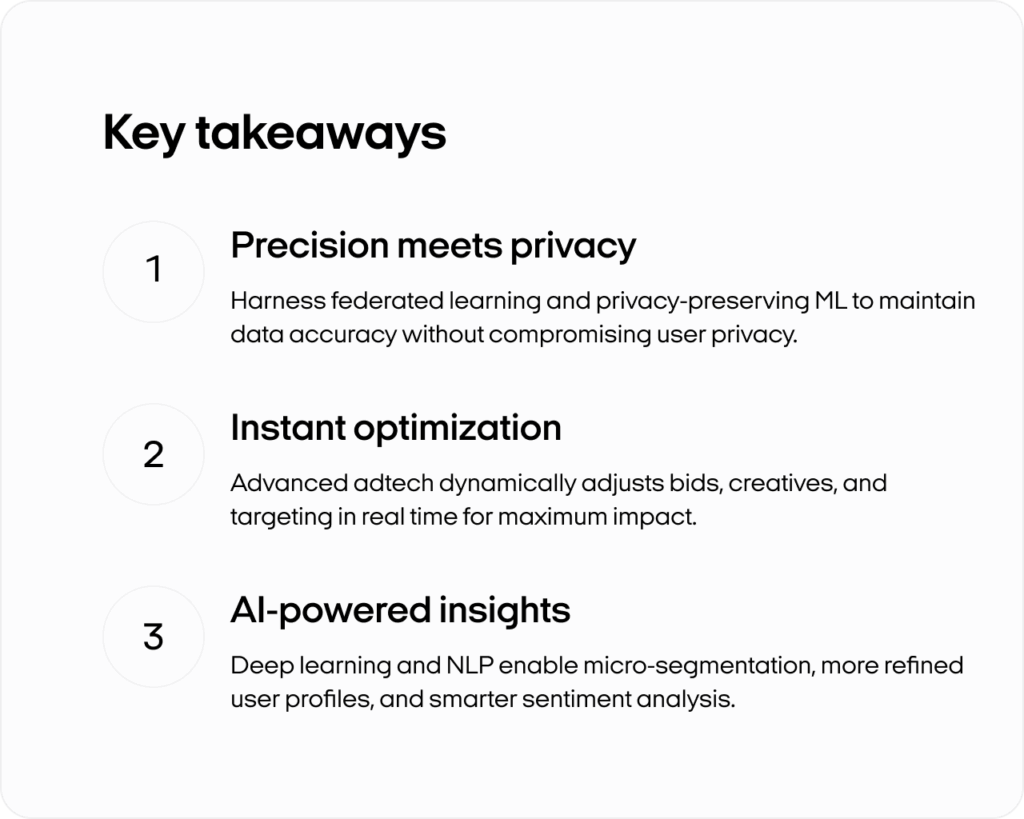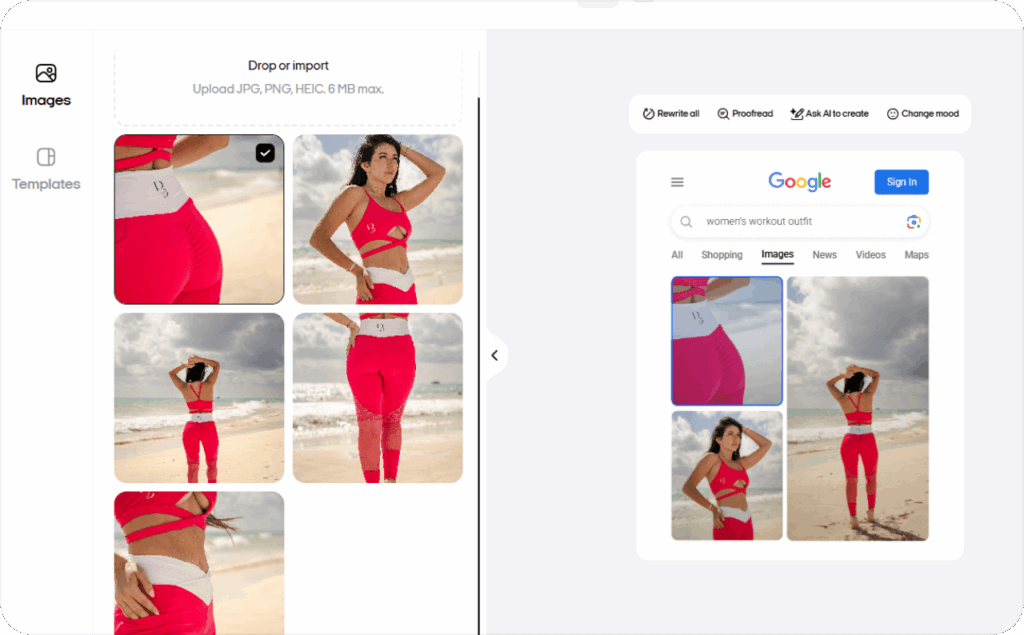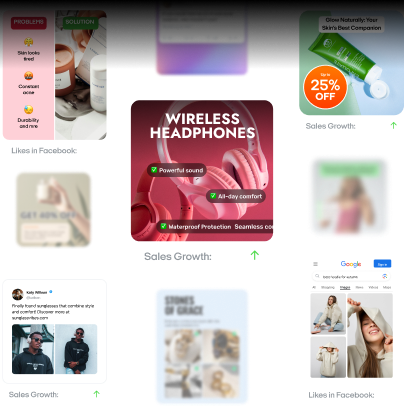Machine learning for ads: 6 reasons marketers should choose it
What if your ads could learn what works and optimize themselves? Here are six reasons marketers are turning to machine learning to make it happen.
Many advertisers pour money into holiday promos, only to see conversions stall. Too often, campaigns rely on guesswork — testing creatives, tweaking placements, and reacting when performance dips. It’s a costly, time-consuming gamble.
Machine learning changes the game by taking the guesswork out of ad targeting. The global AI market reached $184 billion in 2024, up $50 billion from the year before — and it’s on track to surpass $826 billion by 2030. No surprise AI-driven campaigns are dominating digital ads: they deliver.
This is data-powered advertising at its sharpest — fast, efficient, and precise. Here’s why machine learning is no longer optional for advertisers.

Why advertisers need machine learning right now
Imagine launching and optimizing a Facebook campaign for running shoes. You target men aged 18 to 35 who are interested in sports. On paper, it looks like a strong strategy — but in reality, your ad blends into the crowd. Then discover they barely care about fitness gear? This situation is familiar to marketers. Many advertisers face three main headaches:
- Wasted budget: Traditional targeting rests on broad demographics, burning ad spend without reaching truly high-intent shoppers
- Manual labor: Tons of bid tweaks and audience segmentation sap hours — time you could use for brainstorming creatives or scaling campaigns
- Slow adaptation: Rule-based systems can’t keep up with fast-changing consumer trends, leaving ads stale and underperforming
Machine learning shifted the game. It uncovers hidden patterns and adapts in real time. ForceFive Media noticed that AI tools analyze user behavior and demographics to serve highly targeted ads to the most relevant audience, improving the conversion chances. John Doe, AdTech Strategist at Google, sums it up:
“Brands leveraging predictive analytics for digital ads see 20–40% higher ROAS compared to static demographics. It’s about data-driven precision, not guesswork.”
Ready to ditch guesswork and stretch your ad budgets? Read on how to to learn why machine learning outperforms traditional targeting for advertising.
AI vs. Machine learning: What’s the difference?
Artificial Intelligence is a broad umbrella for any technology that mimics human intelligence — from chatbots to self-driving cars. Meanwhile, Machine Learning is a subset of AI that learns from data instead of following explicit rules.
In advertising, ML powers predictive analytics, ad targeting, and automated bidding. It also adapts to user interactions, getting smarter over time. Think of AI as the big picture and ML as the engine that keeps predictive AI marketing campaigns running smoothly.
What exactly is machine learning?
Think of ML as a “learn-as-you-go” system, not a strict script. Traditional rule-based setups say, “If X happens, do Y”. ML evolves by analyzing user interactions, like clicks, views, or time on site, to refine ad targeting and predict who’s most likely to convert. ML’s core components:
- Data is the fuel, covering impressions, clicks, conversions, demographics, and device usage
- Algorithms serve as the “recipes,” teaching models to spot patterns and make predictions
- The models themselves operate in real time, deciding which ads to show for higher engagement
A simple example — Netflix recommendations show based on your viewing history. ML in advertising does the same — matching relevant ads to receptive audiences across billions of impressions.
ML vs. Traditional targeting: A quick comparison
| Aspect | Rule-based / manual | Machine learning-powered |
| Speed | Requires manual updates | Real-time optimization |
| Audience segmentation | Basic demographic filtering | Behavioral & intent-based modeling |
| Ad spend efficiency | High chance of overspending | Precision bidding & lower costs |
| Scalability | Difficult as campaigns grow | Effortless scaling with new data |
ML thrives on continuous learning. It adjusts bids and creatives based on user interactions — no human micromanagement needed.
Why machine learning is a game-changer for adtech
Digital advertising used to rely on static audience segmentation and manual bid tweaks. That often led to wasted budget and low engagement. Now, ML brings data-driven automation to the table, enabling hyper-targeted, cost-effective campaigns that adapt in real time.
By mixing predictive analytics, automated bidding, and behavioral segmentation, ML optimizes ad spend, personalizes messaging, and aligns campaigns with a fast-moving market. According to ForceFive Media:
“The possibilities are limitless, and as AI technology continues to evolve, businesses that embrace AI early will be well-positioned for success.”
Precision targeting: How ML finds high-intent users
Traditional targeting might assume all 18–35-year-old men want sneakers. ML digs deeper. It finds people who’ve searched for running shoes, visited competitor sites, or engaged with fitness content. Predictive analytics spots those signals and focuses ads on users ready to buy.
Some experts say that ML-based segmentation can boost conversion rates by 32%. Relevance means better performance. Intent-based targeting cuts wasted impressions and lifts engagement. Ads reach the users most likely to convert.
Personalization at scale: Right ad, right user, right time
Today’s consumers want ads that feel personal. Dynamic creative optimization, powered by deep learning, customizes headlines, images, and offers to each user’s tastes. If someone searches for tropical vacations, they see beach getaways. Another person interested in skiing sees Alps travel deals. This lifts engagement and brand recall. McKinsey noticed that 71 percent of consumers expect companies to deliver personalized interactions.
Automated bidding: Real-time budget allocation
Without ML, you might set a flat bid and hope it converts. With ML, the system checks factors like time of day, device type, and engagement to auto-adjust bids and avoid pointless clicks. Coca-Cola tried algorithmic ad placement on Facebook, YouTube, and more. By monitoring in real time, they cut acquisition costs by 20% and shifted focus to strategy instead of repetitive tasks. Automated bidding prevents wasted budget, prioritizes high performers, and adapts instantly to market shifts.
Predictive analytics: Forecasting ad performance
Traditionally, you’d wait for an ad to run before checking results. ML-driven predictive analytics flips that script by forecasting performance before launch. It studies historical trends to pinpoint which audiences will respond, which creatives will shine, and how seasonality shapes CTRs.
You can then optimize early, saving budget from wasteful ads. Predictive analytics removes guesswork from planning, letting you allocate budget strategically from the start.
Behavioral targeting & audience segmentation
Instead of relying on demographics alone, ML groups users into micro-cohorts — such as cart abandoners or deal seekers. If someone browses a product multiple times without buying, ML might retarget them with a discount.
At the same time, privacy concerns are rising. That’s why ML is shifting to privacy-friendly approaches like federated learning. It personalizes ads without storing sensitive user data. Behavioral segmentation boosts relevance, increases conversions, and respects user privacy.
Real-time adaptation: Stay on top of trends
Consumer tastes can flip overnight. ML watches live engagement and updates creatives or budget instantly — no human needed. If CTR drops, it tweaks or swaps ads. If “remote work setups” trend, ML shifts budget to home-office offers. ML-driven predictive analytics handles tons of data to power smart ad optimization, beating one-size-fits-all approaches.
Future trends in machine learning for advertising
ML is reshaping digital ads with real-time precision, tailoring user experiences and tapping into rich data insights. As laws tighten and consumer demands rise, staying current is key.
According to Forbes, we’ll see more advances in natural language processing and sentiment analysis, driving even more sophisticated ad strategies after 2024. These breakthroughs could transform how brands connect with consumers and redefine advertising standards.
- Federated learning: Train models locally on user devices rather than big servers. This guards data privacy without losing predictive power. Google’s Privacy Sandbox is a prime example
- Privacy-preserving ML: Methods like differential privacy or homomorphic encryption let brands track aggregated trends without exposing raw user info. That eases privacy fears for wary consumers
- Next-gen adtech & real-time optimization: Advanced systems use ML to instantly tweak bids, creatives, or targeting based on performance. Each impression gets maximum impact
- Deep learning vs. Traditional ML: Classic ML handles structured data well. Deep learning digs into massive datasets, refining user profiles for micro-segmentation and precise targeting
Issues like algorithmic bias and tightening data rules demand ethical, transparent AI. Master these trends to keep consumer trust. Stay ahead of competitors.

Getting started with machine learning for your advertising strategy
ML isn’t just for big budgets. Even SMEs can tap machine learning to sharpen ad targeting, automate bidding, and spike conversions. Here’s a quick roadmap:
- Scale up. When pilot results look promising, expand. Let Zeely AI handle more of your strategy — audience segmentation, creative variations, and dynamic bidding, all in one place
- Pinpoint goals & ML use cases. Define success: lower CPA, higher CTR, or stronger brand awareness. Match these aims with ML tools, like predictive analytics, automated segmentation, or creative optimization
- Select the right ML tools. Look at budget, ease of use, and ad channels. Platforms like Zeely AI combine user-friendly dashboards, multi-channel integration, and ML automation in one setup
- Launch a small pilot first. Don’t spend your entire strategy overnight. Start a limited ad campaign or a targeted audience segment. Test predictive analytics or automated bidding. If it works, go bigger
- Monitor & refine constantly. ML thrives on feedback loops. Track CTR, conversions, and engagement weekly. Tweak your models or bid strategies if something underperforms
Ready to try Zeely AI?

Step 1: Add your product link
Paste your product or service URL into Zeely AI, and it quickly gathers details like images, descriptions, and prices. No website? No problem — just add everything manually.
Step 2: Create a video
Pick the product you want to showcase, then choose a video template built to capture attention. Select an AI avatar that reflects your ideal customer. Zeely will craft a high-converting script using proven marketing strategies, like AIDA, PAS or Before-After-Bridge. Add background music to set the tone, and render your video. In just 7–12 minutes, it’ll be ready to use. While you wait, you can start creating your static creatives.
Step 3: Generate a static ad
Start by choosing the product you want to promote. Pick from over 100 tested templates designed to boost conversions. Zeely AI instantly generates your visuals and copy — no design experience required. Fine-tune images by cropping, resizing, or enhancing. Edit the text yourself or let AI polish it for you. Once you’re happy, hit Save. Your static ad is ready to go live and grow your reach.

Step 4: Launch your ads
Pick the product. Define your campaign objective, like Traffic or Leads. Select an ad platform and prep a mix of static and video ads for A/B testing. Use AI to craft your ad copy and call to action. Next, choose location, age, and gender settings.
Set your budget and campaign duration — 4 days is a smart starting point for Meta to optimize. Run at least 3 creatives to see what clicks with your audience. Once you make the payment, your campaign goes live. Meta usually reviews ads within 24 hours, but thanks to Zeely AI’s official partnership, approval often takes just 1 to 6 hours.
Step 5: Analyze and optimize
Once approved, watch your clicks roll in, live and in real time. When the campaign wraps up, check the results to see what worked. If an ad performs well, save it for future use. You can also spin off similar ads — keep the image and try a new template, or stay creative and test a different CTA.
Experiment to boost results and learn what works. Focus on which creatives grab attention, images perform best, and where to push further.
Conclusion
Machine learning can transform your ads, no matter the size of your business. Start with clear goals and user-friendly tools. Launch a pilot campaign to see real results — sharper targeting, higher conversions, and less manual work. Zeely AI makes it easy by combining automation, simple controls, and real-time analytics in one streamlined platform. Ready to start? Try Zeely AI now with a personalized tour. Discover how ML-driven campaigns supercharge your marketing — no giant budgets or coding skills required.
Also recommended



